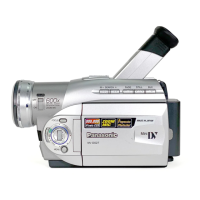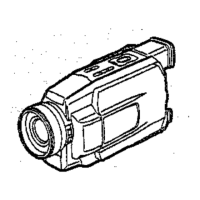You can use the
Progressive
Photoshot
Function at any
time.
In this case,
however, the following
functions
are disabled.
•
Digital Effect Modes in [EFFECT1
J
(-» 25)
•
Digital Zoom [D.ZOOM] («
20)
•
1/750 s or
faster shutter speed
(
24)
When
[PROGRESSIVE] is
set to [AUTO]
You
cannot
use
the
Progressive
Photoshot
Function in the
following
cases.
•When the
zoom magnification is
approximately
15x or
higher
•
When the
shutter speed is 1/750 s
or faster
•When
[EFFECT1] is set to
[WIPE],
[MIX], [STROBE],
[GAINUP],
[TRACER],
[MOSAIC], [MIRROR]
Zoom In/Out
Functions
•When
you
are
zooming on
a
faraway
subject, a
sharper
focus is achieved
if the
recording subject is
1
.7
metres
or
more away from the
Movie Camera.
•
When an
external microphone
is used, the
[Z.MIC]
indication
appears,
but
the Zoom
Microphone function
does
not function.
Image
Stabilizer Function
•The Image
Stabilizer Function does
not operate in a
dimly
lit place. In
this case, the
[0]
Indication lights up.
•
Under
fluorescent lighting,
image brightness may
change
or colours may not
look natural.
•After-images may
appear.
•When a
tripod is used, it is
recommended
that you
turn the
Image
Stabilizer off.
Cinema
Function
•
If you
play back
tape
recorded in
Cinema Mode
on
a
wide-
screen
(16:9)
format
TV, playback size is
automatically
adjusted to
fit the TV screen
format.Please
refer
to
the TV's
operating instructions for
details.
•When images
are displayed on a
TV screen, the
Date/Time
indication may be erased
in some cases.
Motion Sensor Function
•When you use the Motion
Sensor
Function,
It
is
recommended that you use
the AC Adaptor.
•
The
Motion Sensor Function
may not operate in a
dimly lit
place. In this case, the
[MOTION
SENSOR] Indication
flashes.
•
Depending
on
the
colour, size, or
movement of the
recording
subject, the
Motion
Sensor may not
function
properly.
•When setting the Motion
Sensor
Function, [EFFECT1]
on
the
[DIGITAL EFFECT] Sub-Menu and
[SIS] and
[D.ZOOM]
on the
[CAMERA SETUP] Sub-Menu
are automatically
set
to
[OFF].
•
When setting the
Motion Sensor Function,
the
recording
and
search functions
are disabled.
•You cannot record
the beginning of
the movement.
0
Lux
Night View
Function
•The 0
Lux Night View
Function should not be
used in
brightly-lit places,
and the
Movie Camera
should not be
directed toward the sun.
Otherwise,
irreparable damage
may
occur.
•Scenes
taken by the 0
Lux Night View
Function are
played
back in black and white.
•When
recording with
the
0
Lux
Night View
Function,
operating the shutter speed,
iris and
white balance
is not
possible.
•While the 0 Lux
Night View
Function is
operating,
you
cannot use
any of the
Programme AE
Modes.
•When the 0 Lux
Night View Function is
in use, the
subject
should be within
3
metres of
the
Movie Camera.
•If the
Motion-Sensor-Controlled
Recording
Function
is
used
with the 0 Lux
Night View
Function,
the [MOTION
SENSOR]
Indication
may
flash, and you
may not
be
able
to
record
properly.
Programme AE
•
If any
of the
Programme AE Modes is
selected, you
cannot
adjust the
shutter speed
24)
or iris (-* 24).
•You
cannot use
Sports Mode,
Portrait Mode
or
Low-Light
Mode
with Gain-up
Mode
[GAINUP].
Sports Mode
•
During
normal playback, the
image
movement may not
look
smooth.
•Because
the colour and
brightness
of the
playback
image may change,
avoid recording
under fluorescent
light, mercury light, or
sodium light.
•
If you
record
a subject
illuminated
with
strong light or a
highly
reflective
subject,
vertical
lines of
light
may
appear.
•
If
the
light
Is
insufficient, the
[
]
Indication flashes.
•
If
this
mode is used
for indoor
recording, playback
images
may flicker.
Sports
Mode/Portrait
Mode
•if you
record
a
still picture in
Progressive
Photoshot
Mode, the brightness and hue
of the
recorded still
picture may become
unstable.
Low Light
Mode
•
Extremely dark scenes
may not be
able to be made
brighter
to a
satisfactory degree.
Spotlight Mode
•With this mode, recorded
images may
turn out to be
extremely dark.
•If the recording subject is
extremely bright,
its recorded
image may turn out to be
whitish.
Surf
&
Snow Mode
•If the recording subject is
extremely bright, its
recorded
image may
turn
out to
be whitish.
White Balance
•
You
cannot change White
Balance if you set [EFFECT1J
of
[DIGITAL EFFECT] Sub-Menu
on the
[CAMERA
FUNCTIONS] Main-Menu to
[GAINUP],
or if
you
set
[EFFECT2]
to
[SEPIA]
or to
[B/W].
in
the following
cases,
the
[t&n]
Indication flashes:
•The
flashing indicates
that the
previously
adjusted
White
Balance setting is
still kept.
This setting
will
be
kept
until
White
Balance
is adjusted
again.
•You may not be able to achieve
correct White
Balance
Adjustment
manually under weak
illumination.
Manual Shutter Speed
Adjustment
•You may see vertical lines of
light in the
playback image
of
a
brightly shining
subject
or highly
reflective
subject.
•
During normal playback, movement in
the images
may not
look smooth.
•Because the colour and brightness of
the
playback image
may
become
unstable, avoid
recording
under
fluorescent
light,
mercury light,
or sodium
light.
•
If
you
are using either
Gain-up
Mode 25)
or
Programme
AE
Mode (-
22),
you
cannot adjust the
shutter
speed. If
the
shutter
speed was adjusted
manually,
this setting
will
be
cancelled.
Manual Iris Adjustment
•
Depending on zoom magnification,
there are iris
values
that will not be displayed.
•
If you are
using Programme
AE
Mode (-
22),
you
cannot
adjust
the iris. If the iris is adjusted
manually, this
setting
will
be
cancelled.

